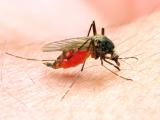Sep 6, 2011 (CIDRAP News) – Researchers from the US Centers Disease for Disease Control and Prevention (CDC) are pressing their case for a test to screen blood donors for the tickborne disease babesiosis, reporting that 162 transfusion-related cases were documented over the past three decades, most of them since 2000.
Babesia microti has become the most frequently reported transfusion-transmitted parasite in the United States. Babesiosis is spread by deer ticks, with most cases concentrated in the Northeast and Upper Midwest. Though the disease causes only a mild-to-moderate infection in many people, for some it can be life-threatening, especially in people with underlying medical conditions—a group most likely to receive transfusions.
The CDC-led case series on transfusion-linked babesiosis cases is based on three decades of passive surveillance, from 1979 through 2009. The group published its findings online yesterday in Annals of Internal Medicine. In January babesiosis became a nationally notifiable disease.
In July 2010 the US Food and Drug Administration's (FDA's) Blood Products Advisory Committee supported the concept of regional donor testing for Babesia. But so far no Babesia test has been approved by the FDA, and no pathogen-reduction techniques for red blood cells (RBCs) or platelets are available in the United States.
Given the lack of data on the burden of transfusion-related babesiosis cases in the United States, the CDC group wrote that its goal was to summarize the reports the agency had received and profile the species involved, along with the time and place of infections.
They included cases in patients that had received one or more cellular blood products between 1979 and 2009, with posttransfusion evidence of Babesia infection detected by 2010. The series included patients who had no other route of Babesia infection, and researchers required that implicated donors have lab evidence of infection.
Investigators found 159 B microti cases, along with 3 infections from B duncani, a type first seen in Washington state in the 1990s. Thirty cases were linked to 12 clusters involving donors who passed along the parasite to more than one recipient.
The cases spanned all four seasons and 19 different states, though most (87%) occurred in seven where B microti is endemic: Connecticut, Massachusetts, Minnesota, New Jersey, New York, Rhode Island, and Wisconsin. The majority (77%) of cases occurred during the last decade of the study period, which the authors called noteworthy. Though the pattern could reflect better recognition and reporting, they contrasted the pattern to the trend for transfusion-linked malaria, of which they received only five reports during that decade.
Nearly all cases were linked to RBC transfusion, across a range of storage ages and processing methods, suggesting the pathogens can survive a host of blood-bank procedures and storage conditions. The median patient age was 65 years.
Barbara Herwaldt, MD, MPH, lead author of the study and medical epidemiologist at the CDC, said in a press release today that the group hopes clinicians become more aware of babesiosis, including the small risk of transmission from blood transfusion. "If a patient develops unexplained fever or hemolytic anemia after a transfusion, babesiosis should be considered as a possible cause, regardless of the season or US region."
In a related editorial in the same issue, David Leiby, PhD, head of transmissible disease at the American Red Cross Laboratory in Rockville, Md., wrote that cases of babesiosis linked to blood transfusion have been rising rapidly, but prior to the CDC study, observers had only anecdotal information and estimated about 70 cases since the first one was detected in 1979.
He wrote that the CDC group's total is probably an undercount, because asymptomatic cases in immunocompetent donors often resolve quickly.
The rise in cases raises questions about whether the parasite's range is increasing, donors are infected more frequently, or healthcare providers are getting better at identifying the disease, Leiby said. He predicted that the new case reporting requirement will help answer those questions. "Although case reporting is still in its infancy, 314 cases of babesiosis have been reported to the Centers for Disease Control and Prevention [this year] through the week ending 20 August 2011," he wrote.
Manufacturers are reluctant to develop a screening test for a regional pathogen, compared with a universal threat such as HIV, Leiby said. However, he noted that some studies suggest that Babesia pathogen reduction for blood is feasible.
"With reports of 162 transfusion-associated cases of babesiosis probably representing only a fraction of actual cases and a potential causal or contributory role for babesiosis in the deaths of B microti–infected blood recipients, the time to act is now," he wrote.
Herwaldt BL, Linden JV, Bosserman E, et al. Transfusion-associated babesiosis in the United States: a description of cases. Ann Intern Med 2011 Sep 5 [Abstract]
Leiby DA. Transfusion-associated babesiosis: shouldn't we be ticked off? Ann Intern Med2011 Sep 5 [Extract]
See also:
Sep 6 CDC press release
















